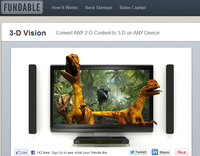Wednesday, August 8, 2012
Gene Dolgoff's 3D Vision: Using Crowdfunding To Turn the World 3D

Santa Monica-based Fundable (www.fundable.com) is a newly launched, crowdfunding site which is headed by local entrepreneur Wil Shroter. Recently, an interesting project popped up on the site--a a 2D to 3D conversion project, from the inventor of the original, LCD projector, Gene Dolgoff. Dolgoff has a fascinating background--he invented the first LCD projector, he helped inspire Star Trek's Holodeck, and he also is a serial entrepreneur who took his company public on the NASDAQ in the 90's. Since Dolgoff is raising money for his 2D-to-3D startup via Fundable, we thought it would be interesting to hear about the project, and how he ended up turning to Fundable.
Tell us about your project?

Gene Dolgoff: After years of research and development, we have developed technology which converts two dimensional video to 3D. Not only that, but we're able to display it on any display device, including TV sets, whether they are 2D or 3D, computers, projectors, and handheld devices. It was a series of different technologies we had ot develop and apply for patents on, and now that we have it, we're working on a prototype. Because we want to get into production, marketing, and sales, right now we're listing on Fundable.com. We have a contest for people to design what the case will look like, and we're using Fundable to raise $10,000 to give to the winner.
Why turn to crowdfunding and Fundable for this?
Gene Dolgoff: We were actually talking before there was a Fundable. We had been talking with another of their companies, the GoBig network, which is a membership organization of investors and entrepreneurs. We have a business plan and private placement on that site, and recently started searching for investors to raise the funds we needed to go into production, and start marketing and sales. We started talking with the folks at GoBig, and they ended up talking to people higher up in the organization, and then we ended up talking with their founders, including Wil. They told us that they were going to start this new, crowdfunding site, and we thought it would be great to be on it and started working together on it.
You've got an interesting story, can you talk about your road here?
Gene Dolgoff: When I was a young kid, I was fascinated by imagery. I wanted to learn about imagery, how the brain works, and how to make 3D images. I started making 3D images when I was thirteen, and at the time I was making lenticular 3D images with the guy who invented that process, victor Anderson. We also made a 3D, CRT television, which may have been the world's first 3D TV, which we had in the Brooklyn Museum in New York. In 1964, I started working on holography, and was one of the first in the world to work on that. Over the next decade, I invented the process of transfering that to printing, to things like credit cards and security applications, and many other different areas. The idea came to me for making a video projector that was brighter and better than CRTs, and it came to me how to do that in 1968.
I started experimenting with materials, and by 1970 I'd settled on liquid crystals, because it was a digital system. I had been a programmer since 1961, and was familiar with digital, and realized that was the way to go. It took until April of 1984, and by 1988 I had met someone to invest in it, and I started the world's first digital projector company, Projectavision. We got a contract form DARPA, the Defense Department agency in 1989, went public in 1999, raised $20M, and got lots of patents, licensed it to lots of companies, and also made our own product which showed up in stores. I was doing that until 1995. After I left, I started working on a lot of different areas, and one of those was 3D, lenticular printing. It was so much more advanced than back in 1960's, and we started selling posters in 3D for advertising. By late 2005 and 2006, we saw the return of 3D movies, made possible by the digital projectors. I realized now was the time to focus on consumer applications, because eventually everyone would want 3D TV in their home. So, we started developing the technology, and once that we put that together, we started looking for funding.
Can you talk a bit about your technology, and how it's different from other, 3D technology out there?
Gene Dolgoff: There are basically three kinds of 3D converters, besides ours. One is the manual technique, which uses rotoscoping, which requires a graphic artist to sit at a workstation, and convert frame-by-frame into 3D. To convert a single, full length movie, that takes hundreds of graphic artists, four months, and five to 15 million dollars. That's only good for blockbuster movies, and that's prohibitive for television. There also automatic converters. There are two kinds besides ours. One is really fake, and is the "simulated 3D" that most converters use, which essentially offsts different lines on the screen different amounts, which makes a picture look like it has different depth. It doesn't have any correlation to the real depth in the scene. The second kind uses something which are called depth maps, which are algorithms that assign different properties to different depths, for example, you might look at the brightness of an image to try to determine depth, which has a little more do to with actual depth and is more accurate. The problem there, is it requires lots more computing overhead, and requires a much bigger, more expensive machine. That usually causes lag, and that's prohibitive when you're playing a game.
Then, there is our system. Our system uses a different technique, based on the study of the human brain over the past 40 years. We look at two frames at a time, and look at all the 3D factors. You'll notice that most of the time, more depth means a scene has differences in brightness, contrast, and color saturation, and are higher in the frame. Plus, when a camera moves back and forth, the slower and object is, the further back it is. All of these factors are taken into account, and we get an image which is stereoscopically aligned with the algorithm in our brain. The workload of our computing is greatly reduced, and lots of this is done in the human brain. The actual depth information is detected and placed in a lot of the areas of the scene. It's not the actual depth, but when the brain sees actual depth in the areas, it fills in the rest of the missing depth informatoin in the area, by remembering its previous 3D experience. That's how this is able to create good, 3D with accuracy, yet with low compute overhead.
We understand you had a hand in the idea behind Star Trek's Holodeck, can you tell us the story behind that?
Gene Dolgoff: Back when I was doing holography work in the late 60's, I was also studying physics and making some amazing discoveries. When I realized that the basis of holography was the interference of energy, I realized it was also the basis of everything in the universe. One of the things that occurred to me, that if matter is made of interference patterns of energy, and you were already able to record that to make up a holographic image, it should be someday possible to record the interaction of energy that makes up matter. I had been talking about that, and wound up meeting someone at a lecture in 1973. She happened to be a good friend of Gene Rodenberry, and introduced me to him. I was so thrilled--I was a big Star Trek Fan--and spend the day with him and his wife. I also got to show him holograms, how they work, and told him he had to include them in Star Trek. I told him--this is going to be part of the future, and you have to include it in the show. You've got replicators, transporters, and that's how holographs work. I described to him actually something like a Holodeck, a place where people could go and interact like things were real. We went back and forth on it, and eventually it built it into Star Trek the Next Generation.
Fascinating story. Back to the company--at one point you had started a company and taken the more traditional route of taking it public - why the different approach this time?
Gene Dolgoff: We find that in today's economy, it's really harder to raise funds than back in the early 2000's. Investors are a lot more skeptical, and a lot more risk adverse. They're more focused on looking for companies that already have products on the market and are profitable. For a company like us, where we don't have a product out yet, there are very few investors willing to consider it. We saw some really dramatic successes from crowdfunding sites by others, and though this might be a really good way to go.
What's the next step for your project?
Gene Dolgoff: We're actively looking for investors now that will allow us to get into production, and we're hoping we can make our first production prototypes by Christmas. We hope to then get into full production in the spring, and certainly by summer have products in the store and ready for the next Christmas season.
Thanks!